- CMSD Media Center
- Latest
Return to Headlines

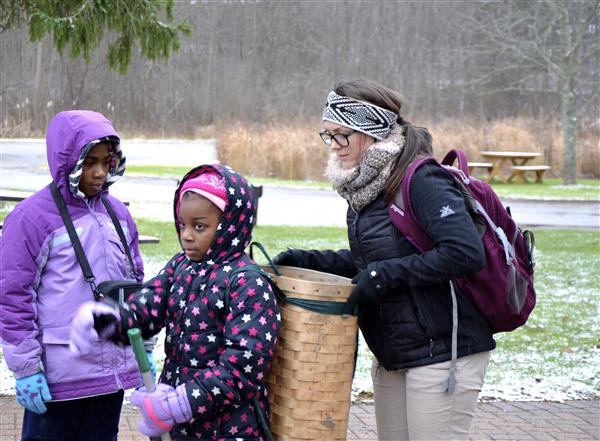
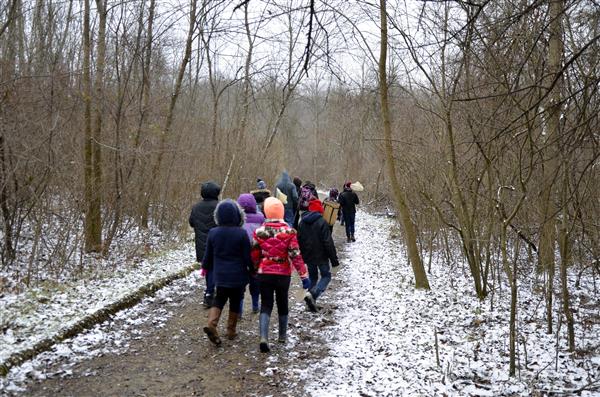
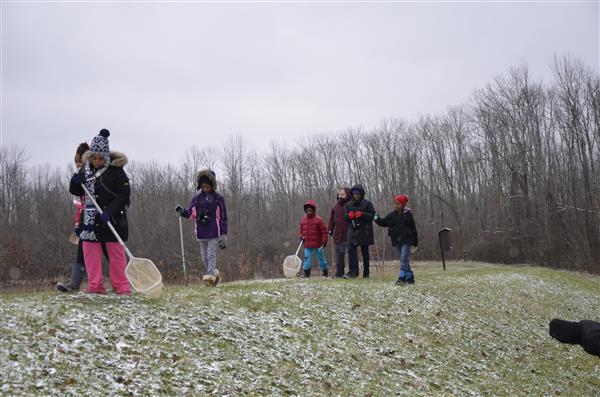
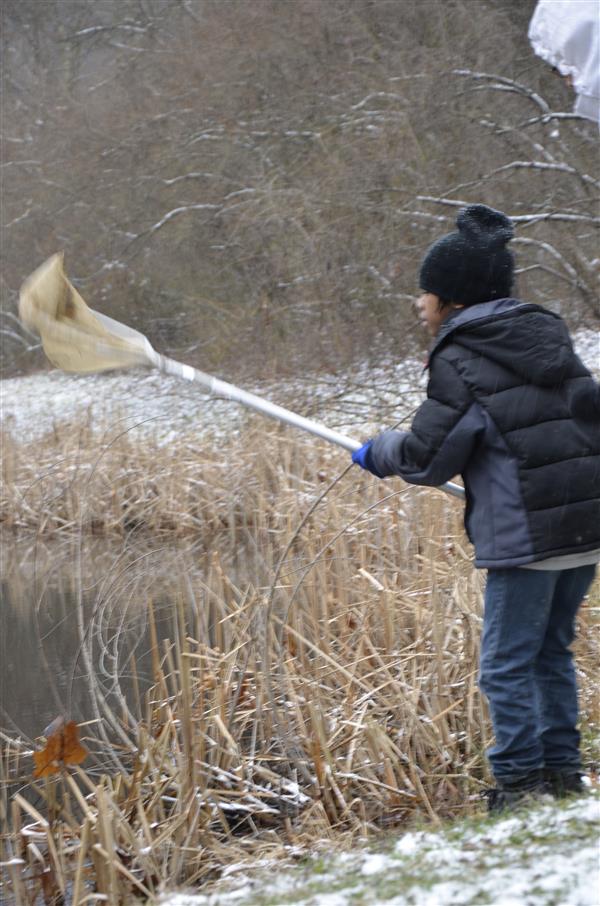
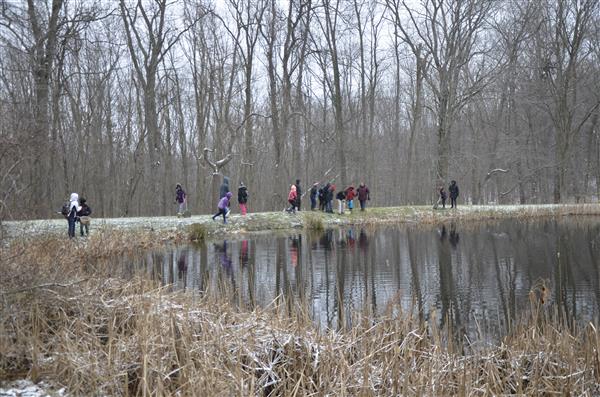
CMSD, meet CVNP.
After lunch Wednesday, education center intern Stephanie Cooper, a Cleveland State University environmental sciences graduate, led one of the groups on a hike (see photos above) into the fields, nearby woods and the area around a pair of small ponds on the property. She handed out laminated cards asking students to find certain items, such as evidence of an animal (antler marks on a tree, a hole in the ground) or something alive (bugs under a log).
“We learn a lot about ecosystems and science and everything, but we also learn a lot about each other,” she said. “People learn to live with each other.”
Angelique Shields, a teacher in the multi-handicapped/autism unit at the school, agreed that the closeness of a “camping” experience was important.
“I've had many of them for the last three years, but the talk at night as we're about to fall asleep is unlike anything before,” she said. “They are full of questions, and they are understanding better that there is learning in everything that we do.”
Other faculty on the trip included peer coach Kirkland, eighth-grade teacher Tomas Gauvin and second-grade teacher Jane Stange. Two others, eighth-grade teacher Alice Hill and speech pathologist Robert McEntee, made the trip with older students in November, Sindyla said.
Michael R. White students make national park their classroom (photo gallery)


CMSD NEWS BUREAU
12/10/2014Jen Sindyla, a fourth-grade teacher at Michael R. White STEM School, didn't even blink when afternoon snow began falling in her "classroom" Wednesday afternoon. And fellow teacher DeAnn Kirkland simply smiled when a few of her students rolled over a log and dug up a weird looking and nearly frozen bug.
Kirkland even applauded as other students scooped a netful of cold, slimy muck from a shallow pond and picked through it to find slugs, crawfish and tadpoles.
CMSD, meet CVNP.
About 50 students and five teachers from the District's Michael R. White STEM School are on an extended field trip at the Cuyahoga Valley Environmental Education Center's 500-acre conference center and dormitories. They arrived Tuesday and will leave for home early Friday afternoon.
The students and their teachers are staying at the Cuyahoga Valley National Park site overnight so they can be on site during the day to study the various aspects of healthy watersheds. They are in the classroom three times a day and in the field, including a trip to the Cuyahoga River for scientific water sampling, Sindyla said.
After lunch Wednesday, education center intern Stephanie Cooper, a Cleveland State University environmental sciences graduate, led one of the groups on a hike (see photos above) into the fields, nearby woods and the area around a pair of small ponds on the property. She handed out laminated cards asking students to find certain items, such as evidence of an animal (antler marks on a tree, a hole in the ground) or something alive (bugs under a log).
"Hey! I found something!" one fourth-grade girl yelled out when she found moss on a rock. "I didn't think the moss would still be alive in the winter."
The hike through the winter environs was just part of the experience for the CMSD students, who are also spending three classroom sessions a day learning from experts from the Conservancy for CVNP and their teachers as they complete a nearly 50-page booklet called "All The Rivers Run."
The 33,000-acre national park is centered on the Cuyahoga River valley between Akron and Cleveland. According to its web site, the park is home to more than 900 plant species, 194 bird species and dozens of fish, mammals, amphibians and reptiles -- not to mention 91 aquatic macro-invertebrates, some of which were pulled from the water by the CMSD students.
The president of the Michael R. White student council joined a handful of other older students on the trip as mentors to their younger classmates. She said staying together in the dormitory-style accommodations is as important as the academics.
“We learn a lot about ecosystems and science and everything, but we also learn a lot about each other,” she said. “People learn to live with each other.”
Angelique Shields, a teacher in the multi-handicapped/autism unit at the school, agreed that the closeness of a “camping” experience was important.
“I've had many of them for the last three years, but the talk at night as we're about to fall asleep is unlike anything before,” she said. “They are full of questions, and they are understanding better that there is learning in everything that we do.”
Other faculty on the trip included peer coach Kirkland, eighth-grade teacher Tomas Gauvin and second-grade teacher Jane Stange. Two others, eighth-grade teacher Alice Hill and speech pathologist Robert McEntee, made the trip with older students in November, Sindyla said.
Sindyla said she began bringing Michael R. White students to the national park three years ago with help from various partners, including the education center, KeyBank and Time Warner Cable.
"This is a very educationally rich program," she said. "This is not one of those 'Let's go canoeing and horseback riding.' Here, they experience what they are studying, they do the experiments that help them understand the essential question: 'What does it mean to live in a healthy watershed?'"
Sindyla said she has been teaching her students about the Great Lakes and the Lake Erie watershed, but realized immediately that some of her students needed a primer on their own region.
"Our school is less than a mile from Lake Erie, but we have students here who have never seen the lake in person," she said. "Some of the young ones even think there are sharks in there. But they've learned a lot this week that has added to what we've been teaching them."
And the lesson isn't over.
Sindyla said she hopes to have the students help come up with a recommendation to the District for an eco-friendly design for a new Michael R. White, which may be among some 20 schools scheduled to be replaced with money from a recently approved bond issue.
"We want to show the District that what we've learned could have a benefit not only to us now, but to future generations at Michael R. White," she said.

